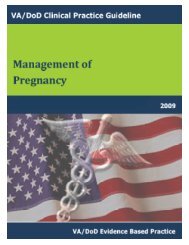DM Full Guideline (2010) - VA/DoD Clinical Practice Guidelines Home
DM Full Guideline (2010) - VA/DoD Clinical Practice Guidelines Home
DM Full Guideline (2010) - VA/DoD Clinical Practice Guidelines Home
Create successful ePaper yourself
Turn your PDF publications into a flip-book with our unique Google optimized e-Paper software.
Version 4.0<br />
<strong>VA</strong>/<strong>DoD</strong> <strong>Clinical</strong> <strong>Practice</strong> <strong>Guideline</strong><br />
for the Management of Diabetes Mellitus<br />
D. Follow-Up Examination Yearly Or According To Eye Care Provider-Recommended Schedule<br />
OBJECTIVE<br />
Establish a follow-up interval for patients based on the risk for retinopathy development or progression.<br />
RECOMMENDATIONS<br />
1. Patients who have had no retinopathy on all previous examinations should be screened for retinopathy at<br />
least every other year (biennial screening). More frequent retinal examinations in such patients should be<br />
considered when risk factors associated with an increased rate of progression of retinopathy are present. [B]<br />
2. Patients with existing retinopathy should be managed in conjunction with an eye care professional and<br />
examined at intervals deemed appropriate for the level of retinopathy. [I]<br />
DISCUSSION<br />
The inability of symptoms alone to accurately predict the presence or severity of retinopathy necessitates regularly<br />
scheduled retinal examinations for patients with diabetes. Some patients will remain retinopathy-free for several<br />
years, but the course of diabetic eye disease cannot be reliably predicted for a given individual. Risk factors for<br />
progression of retinopathy include: poorly controlled HbA 1 c (e.g. >9.0), rapid and substantial HbA 1 c improvement<br />
(a decrease of approximately 2% or greater over 160 mm Hg). In light of these associations, it is<br />
prudent to perform more frequent retinal examinations in such patients. Clinicians should exert caution in extending<br />
biennial examinations to patients with factors associated with a higher likelihood of retinopathy progression.<br />
Duration of disease is most strongly associated with retinopathy in individuals with type 1 <strong>DM</strong>. The prevalence of<br />
proliferative retinopathy approaches 30% after 15 years of diabetes and may rise to as much as 50% after 20 years.<br />
Although the prevalence of proliferative disease is lower in type 2 diabetes, the prevalence of any retinopathy<br />
approaches 75% in insulin-treated patients with longer duration of diabetes and the prevalence of proliferative<br />
retinopathy may exceed 20%. Different patients may exhibit separate and unique rates of retinopathy development<br />
or progression, but the likelihood of ocular involvement increases with duration of diabetes.<br />
Macroalbuminuria (i.e. nephropathy) and lower extremity amputation are also associated with the presence of<br />
retinopathy. Although the relationship may not be causal, these patients typically have long-standing or advanced<br />
complications from diabetes and are likely to have other evidence of microvascular disease.<br />
Pregnancy may be associated with rapid deterioration of existing retinopathy and a higher risk of progression to<br />
vision threatening disease. A woman with pre-existing diabetes who becomes pregnant should be examined at the<br />
time of diagnosis and if she has greater than minimal retinopathy, repeat examinations should be performed at 4-6<br />
week intervals. Proliferative retinopathy or clinically significant macular edema should be treated promptly. Those<br />
with less severe retinopathy should be monitored closely throughout their pregnancy (i.e. during each trimester). In<br />
the absence of an eye examination within the previous twelve months, patients who are pregnant should have an<br />
expedited appointment for a retinopathy evaluation. In addition, regardless of the timing of the last eye examination,<br />
the patient’s eye care provider should be notified of the pregnancy.<br />
Retinopathy of any level can progress rapidly over the course of a year and occasionally even mild retinopathy will<br />
progress to proliferative retinopathy within that time frame. As follow-up intervals shorter than 12 months may be<br />
indicated for some of these individuals, patients with retinopathy who have not had a retinal exam within the<br />
previous year should be referred for an expedited retinal evaluation. Patients who have previously undergone laser<br />
therapy have already reached the stage of vision threatening diabetic eye disease. These patients require close follow<br />
up and in the absence of information to the contrary should be considered at high risk for vision loss and receive an<br />
expedited examination if they have not had one within the previous year.<br />
Module E – Eye care Page 92
















